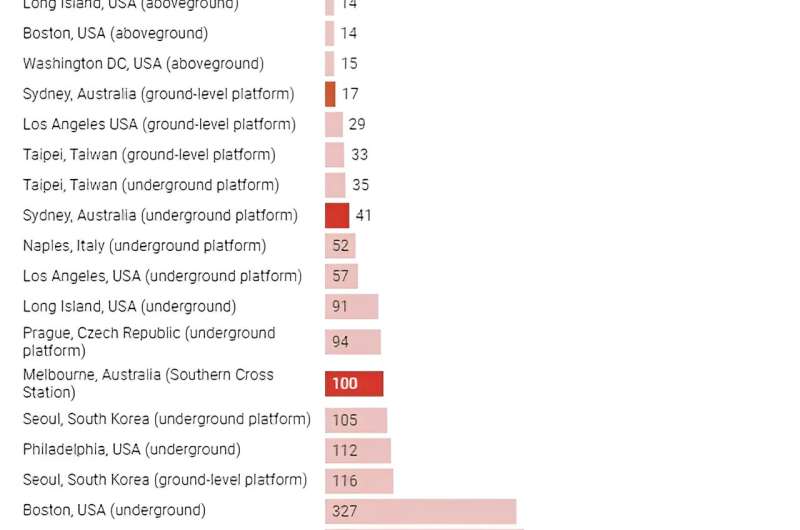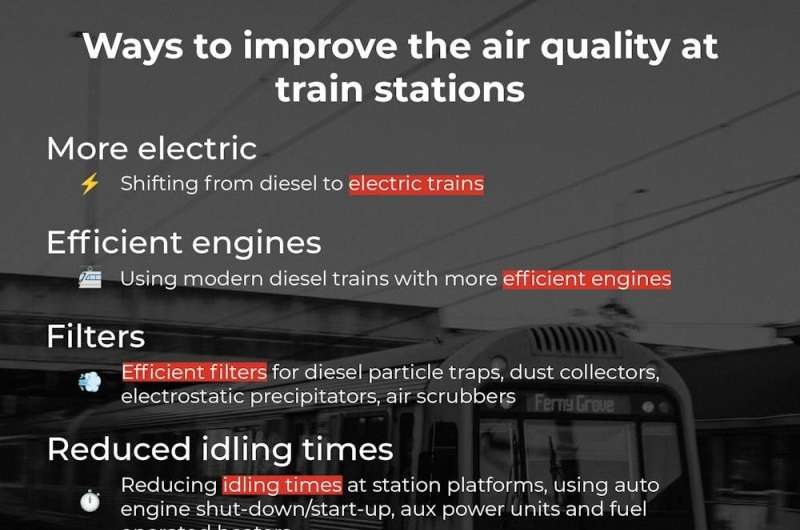This article has been reviewed according to Science X's editorial process and policies. Editors have highlighted the following attributes while ensuring the content's credibility:
fact-checked
trusted source
written by researcher(s)
proofread
Air quality at many train stations is alarmingly bad—here's how to improve it

Recent revelations about poor air quality at Melbourne's Southern Cross Station probably came as no surprise for passengers who have experienced such conditions.
Train platforms, bus terminal and nearby areas have recorded alarmingly poor air quality. In some parts of the station, nitrogen dioxide levels were more than 90 times the World Health Organization's (WHO) recommended limit. At such levels, considered much higher than medically acceptable, human health is at risk.
Poor air quality in train stations is a concern in many major cities, including Sydney, New York and Boston in the US, and London and Edinburgh in the UK. In some Sydney stations and tunnels, air pollution was up to five times worse than the WHO's recommended limit.
Poor air quality is a result of fumes from diesel engines, restricted airflow, station design and the wear of train components. These emissions include tiny airborne particles. This fine particulate matter can cause illness and disease. Passengers, workers and nearby residents may all be affected.
Solutions already exist. Investing in technology, alternative fuels, electrification and better management of stations can improve air quality and reduce the health risks. As with COVID, people can also reduce their exposure by wearing suitable face masks, such as P2 and N95 masks.
It's a worldwide problem
International studies show poor air quality is common in enclosed train and bus stations. Data for most stations from many cities show levels of fine particulate matter exceeded WHO guidelines.
In Sao Paolo, Brazil, a study found "time spent inside a bus terminal can result in an intolerable health risk for commuters".

A Danish study identified much higherpollution levels of pollutants in and around diesel trains than for electric trains. Inside the diesel trains, levels of ultrafine particulate matter were 35 times higher, black carbon six times higher, nitrogen oxides (NOx) eight times higher, PM2.5 (particles with a diameter of 2.5 micrometers or less, so they can enter the bloodstream) twice as high and benzo(a)pyrene six times higher.
But aren't trains a more sustainable form of transport?
In terms of sustainability and general urban air quality, trains help reduce emissions and air pollution when compared to cars and trucks in Australia. Trains transport people more efficiently, with a much smaller land, energy and emissions footprint.
The health impacts of air pollution are usually lower for train commuters than those who commute by car. However, the impacts on train commuters depend on location, the fuel used (diesel or electric) and the extent of their exposure to highly polluted air in enclosed and underground stations.
What can be done to improve air quality?
Rail operators can do many things to help passengers breath more easily. These involve both trains and station management.
Train-side interventions include the use of cleaner fuels, more efficient engines and filtering systems, and shifting from diesel to electric trains.
Station-side solutions include exhaust fans, station design and real-time monitoring of air quality. Optimizing schedules and operations can reduce train engine idling time. Loading and unloading facilities can be relocated away from congested areas.
Alternative fuels
Train operators have trialed the use of biofuels, typically blended with mineral diesel. Biodiesel and renewable diesel are made from renewable resources and burn cleaner. Biofuels can cut greenhouse gas emissions by up to 86%.
Biodiesel costs nearly the same as mineral diesel, but renewable diesel costs more.
Technology fixes
Exhaust after-treatment systems on diesel engines are a low-cost option. Filters can capture most soot particles. Selective catalytic reduction technology uses a chemical reaction to reduce NOx emissions.
Improving ventilation and air flow within stations can also help limit pollution.
Another option is diesel-hybrid train fleet conversion. Electric traction modules and energy-storage systems recover energy when the train brakes and store it in a battery for later use.
These systems can operate the train when the diesel engines are shut down, for example during boarding. Energy savings can be up to 6,000kWh/day.
The South Australian government has retrofitted trains with these systems. They can cut fuel use by up to 20% and carbon dioxide emissions by 2,400 tons a year on the Adelaide Metro.
Electrification
Electric trains produce much less air pollution—around 20-30% less greenhouse gas emissions per passenger kilometer.
Being lighter and more efficient, electric trains are also cheaper to make, maintain and run than diesel trains (with average savings of 20%, 33% and 45% respectively).
Cleaner air saves lives
Estimating health impacts in Australia is difficult due to limited data, but international evidence provides guidance.
Compared to travel on roads, commuters on trains and metros typically have less exposure to air pollution, except for black carbon. Long-term exposure to black carbon typically increases mortality rates even at low levels of ambient air pollution.
At exposure levels close to what is often found in cities, excess lifetime lung cancer mortality is 0.3 per 1,000. For train staff, Danish research estimates black-carbon exposure results in an extra 16 lung cancer deaths per 1,000 individuals over a lifetime (assuming an eight-hour working day). For working conditions over ten years, a six-fold increase in black carbon lifts this rate to 1.9 per 1,000. A ten-fold increase takes it to 3.2 extra deaths per 1,000.
Short-term exposure to high air pollution is also linked to deaths from kidney disease.
Leadership is needed to protect people and the planet
Some solutions are easy to apply immediately. Others require planning and foresight.
The impacts on rail costs and operations should be balanced against the importance of protecting the health of commuters and staff, as well as cutting emissions.
Active monitoring and transparent reporting of air quality promote public trust. They're also needed to assess the effectiveness of solutions.
Shifting towards a cleaner rail system is an opportunity for operators and regulators to show vision and leadership by supporting trains as one of the best alternatives to cars and trucks.
Provided by The Conversation
This article is republished from The Conversation under a Creative Commons license. Read the original article.![]()





















